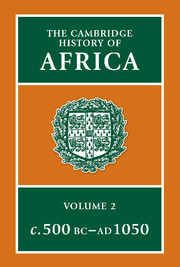Book contents
- Frontmatter
- Introduction
- 1 The legacy of prehistory: an essay on the background to the individuality of African cultures
- 2 North Africa in the period of Phoenician and Greek colonization, c. 800 to 323 BC
- 3 North Africa in the Hellenistic and Roman periods, 323 BC to AD 305
- 4 The Nilotic Sudan and Ethiopia, c. 660 bc to c.ad 600
- 5 Trans-Saharan contacts and the Iron Age in West Africa
- 6 The emergence of Bantu Africa
- 7 The Christian period in Mediterranean Africa, c.ad 200 to 700
- 8 The Arab conquest and the rise of Islam in North Africa
- 9 Christian Nubia
- 10 The Fatimid revolution (861–973) and its aftermath in North Africa
- 11 The Sahara and the Sudan from the Arab conquest of the Maghrib to the rise of the Almoravids
- Bibliographical essays
- Bibliography
- Index
- Plate Sections
- Plate Sections
- Plate Sections
- References
4 - The Nilotic Sudan and Ethiopia, c. 660 bc to c.ad 600
Published online by Cambridge University Press: 28 March 2008
- Frontmatter
- Introduction
- 1 The legacy of prehistory: an essay on the background to the individuality of African cultures
- 2 North Africa in the period of Phoenician and Greek colonization, c. 800 to 323 BC
- 3 North Africa in the Hellenistic and Roman periods, 323 BC to AD 305
- 4 The Nilotic Sudan and Ethiopia, c. 660 bc to c.ad 600
- 5 Trans-Saharan contacts and the Iron Age in West Africa
- 6 The emergence of Bantu Africa
- 7 The Christian period in Mediterranean Africa, c.ad 200 to 700
- 8 The Arab conquest and the rise of Islam in North Africa
- 9 Christian Nubia
- 10 The Fatimid revolution (861–973) and its aftermath in North Africa
- 11 The Sahara and the Sudan from the Arab conquest of the Maghrib to the rise of the Almoravids
- Bibliographical essays
- Bibliography
- Index
- Plate Sections
- Plate Sections
- Plate Sections
- References
Summary
THE ORIGINS OF MEROITIC CIVILIZATION
The ancient Egyptians had entered what is now the northern Sudan, known to them as Kush (perhaps the native name), in about 1500 BC and had rapidly occupied it as far upstream as Kurgus, near to the modern Abu Hamed. During the five hundred or so years of their rule, they had effected a transformation in the life of the country by forming an effective structure of Egyptian administration and by the building of towns and temples. What influence this had on indigenous village life is not certain, since archaeological investigation has as yet thrown no light on this interesting question; but there seems little doubt that chiefly families were much influenced and it is likely that numbers of richer Kushites had moved into the towns and adopted many Egyptian customs and ways of life.
The nature of the end of Egyptian rule in Kush is extremely obscure, but by the latter part of Dynasty XX Egyptian troops and administrators were gone, and by c. 750 BC the beginnings of an independent Kushite state can be seen. The evidence for this and for the subsequent invasion of Egypt by Piankhy (or Piy as he should perhaps be called) and Taharqa, who, with their successors, are known in Egyptian history as Dynasty XXV, as well as some indication of Kushite influence in Egypt and the origins of the royal family, is given in Volume 1, chapter 12 of this History and need not be repeated here.
- Type
- Chapter
- Information
- The Cambridge History of Africa , pp. 210 - 271Publisher: Cambridge University PressPrint publication year: 1979



